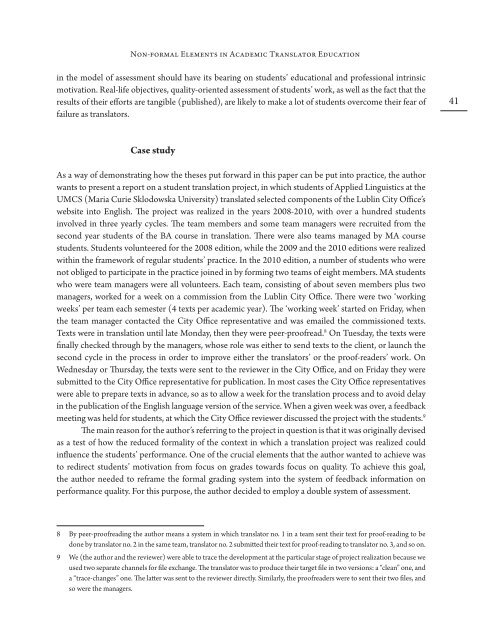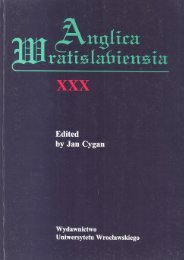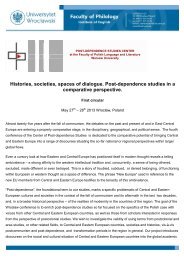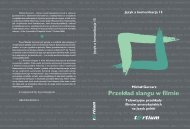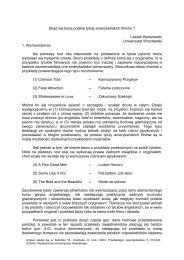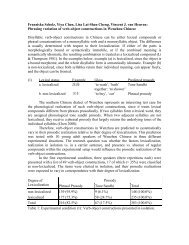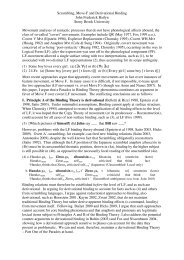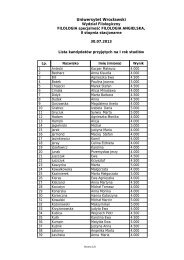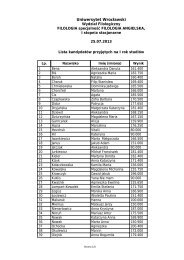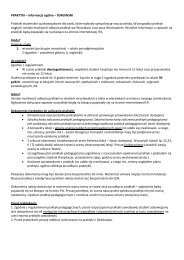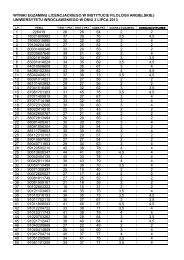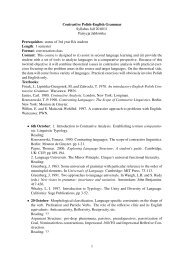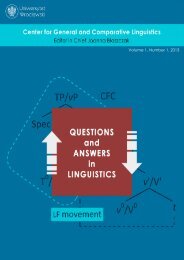Academic Journal Modern Philology
Academic Journal Modern Philology
Academic Journal Modern Philology
Create successful ePaper yourself
Turn your PDF publications into a flip-book with our unique Google optimized e-Paper software.
Non-formal Elements in <strong>Academic</strong> Translator Education<br />
in the model of assessment should have its bearing on students’ educational and professional intrinsic<br />
motivation. Real-life objectives, quality-oriented assessment of students’ work, as well as the fact that the<br />
results of their efforts are tangible (published), are likely to make a lot of students overcome their fear of<br />
failure as translators.<br />
41<br />
Case study<br />
As a way of demonstrating how the theses put forward in this paper can be put into practice, the author<br />
wants to present a report on a student translation project, in which students of Applied Linguistics at the<br />
UMCS (Maria Curie Sklodowska University) translated selected components of the Lublin City Office’s<br />
website into English. The project was realized in the years 2008-2010, with over a hundred students<br />
involved in three yearly cycles. The team members and some team managers were recruited from the<br />
second year students of the BA course in translation. There were also teams managed by MA course<br />
students. Students volunteered for the 2008 edition, while the 2009 and the 2010 editions were realized<br />
within the framework of regular students’ practice. In the 2010 edition, a number of students who were<br />
not obliged to participate in the practice joined in by forming two teams of eight members. MA students<br />
who were team managers were all volunteers. Each team, consisting of about seven members plus two<br />
managers, worked for a week on a commission from the Lublin City Office. There were two ‘working<br />
weeks’ per team each semester (4 texts per academic year). The ‘working week’ started on Friday, when<br />
the team manager contacted the City Office representative and was emailed the commissioned texts.<br />
Texts were in translation until late Monday, then they were peer-proofread. 8 On Tuesday, the texts were<br />
finally checked through by the managers, whose role was either to send texts to the client, or launch the<br />
second cycle in the process in order to improve either the translators’ or the proof-readers’ work. On<br />
Wednesday or Thursday, the texts were sent to the reviewer in the City Office, and on Friday they were<br />
submitted to the City Office representative for publication. In most cases the City Office representatives<br />
were able to prepare texts in advance, so as to allow a week for the translation process and to avoid delay<br />
in the publication of the English language version of the service. When a given week was over, a feedback<br />
meeting was held for students, at which the City Office reviewer discussed the project with the students. 9<br />
The main reason for the author’s referring to the project in question is that it was originally devised<br />
as a test of how the reduced formality of the context in which a translation project was realized could<br />
influence the students’ performance. One of the crucial elements that the author wanted to achieve was<br />
to redirect students’ motivation from focus on grades towards focus on quality. To achieve this goal,<br />
the author needed to reframe the formal grading system into the system of feedback information on<br />
performance quality. For this purpose, the author decided to employ a double system of assessment.<br />
8 By peer-proofreading the author means a system in which translator no. 1 in a team sent their text for proof-reading to be<br />
done by translator no. 2 in the same team, translator no. 2 submitted their text for proof-reading to translator no. 3, and so on.<br />
9 We (the author and the reviewer) were able to trace the development at the particular stage of project realization because we<br />
used two separate channels for file exchange. The translator was to produce their target file in two versions: a “clean” one, and<br />
a “trace-changes” one. The latter was sent to the reviewer directly. Similarly, the proofreaders were to sent their two files, and<br />
so were the managers.


